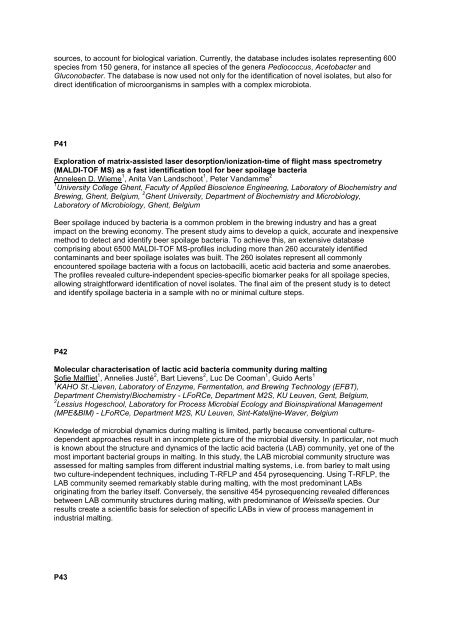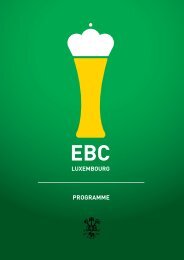here - the 34th European Brewery Convention
here - the 34th European Brewery Convention
here - the 34th European Brewery Convention
You also want an ePaper? Increase the reach of your titles
YUMPU automatically turns print PDFs into web optimized ePapers that Google loves.
sources, to account for biological variation. Currently, <strong>the</strong> database includes isolates representing 600<br />
species from 150 genera, for instance all species of <strong>the</strong> genera Pediococcus, Acetobacter and<br />
Gluconobacter. The database is now used not only for <strong>the</strong> identification of novel isolates, but also for<br />
direct identification of microorganisms in samples with a complex microbiota.<br />
P41<br />
Exploration of matrix-assisted laser desorption/ionization-time of flight mass spectrometry<br />
(MALDI-TOF MS) as a fast identification tool for beer spoilage bacteria<br />
Anneleen D. Wieme 1 , Anita Van Landschoot 1 , Peter Vandamme 2<br />
1 University College Ghent, Faculty of Applied Bioscience Engineering, Laboratory of Biochemistry and<br />
Brewing, Ghent, Belgium, 2 Ghent University, Department of Biochemistry and Microbiology,<br />
Laboratory of Microbiology, Ghent, Belgium<br />
Beer spoilage induced by bacteria is a common problem in <strong>the</strong> brewing industry and has a great<br />
impact on <strong>the</strong> brewing economy. The present study aims to develop a quick, accurate and inexpensive<br />
method to detect and identify beer spoilage bacteria. To achieve this, an extensive database<br />
comprising about 6500 MALDI-TOF MS-profiles including more than 260 accurately identified<br />
contaminants and beer spoilage isolates was built. The 260 isolates represent all commonly<br />
encountered spoilage bacteria with a focus on lactobacilli, acetic acid bacteria and some anaerobes.<br />
The profiles revealed culture-independent species-specific biomarker peaks for all spoilage species,<br />
allowing straightforward identification of novel isolates. The final aim of <strong>the</strong> present study is to detect<br />
and identify spoilage bacteria in a sample with no or minimal culture steps.<br />
P42<br />
Molecular characterisation of lactic acid bacteria community during malting<br />
Sofie Malfliet 1 , Annelies Justé 2 , Bart Lievens 2 , Luc De Cooman 1 , Guido Aerts 1<br />
1 KAHO St.-Lieven, Laboratory of Enzyme, Fermentation, and Brewing Technology (EFBT),<br />
Department Chemistry/Biochemistry - LFoRCe, Department M2S, KU Leuven, Gent, Belgium,<br />
2 Lessius Hogeschool, Laboratory for Process Microbial Ecology and Bioinspirational Management<br />
(MPE&BIM) - LFoRCe, Department M2S, KU Leuven, Sint-Katelijne-Waver, Belgium<br />
Knowledge of microbial dynamics during malting is limited, partly because conventional culturedependent<br />
approaches result in an incomplete picture of <strong>the</strong> microbial diversity. In particular, not much<br />
is known about <strong>the</strong> structure and dynamics of <strong>the</strong> lactic acid bacteria (LAB) community, yet one of <strong>the</strong><br />
most important bacterial groups in malting. In this study, <strong>the</strong> LAB microbial community structure was<br />
assessed for malting samples from different industrial malting systems, i.e. from barley to malt using<br />
two culture-independent techniques, including T-RFLP and 454 pyrosequencing. Using T-RFLP, <strong>the</strong><br />
LAB community seemed remarkably stable during malting, with <strong>the</strong> most predominant LABs<br />
originating from <strong>the</strong> barley itself. Conversely, <strong>the</strong> sensitive 454 pyrosequencing revealed differences<br />
between LAB community structures during malting, with predominance of Weissella species. Our<br />
results create a scientific basis for selection of specific LABs in view of process management in<br />
industrial malting.<br />
P43





